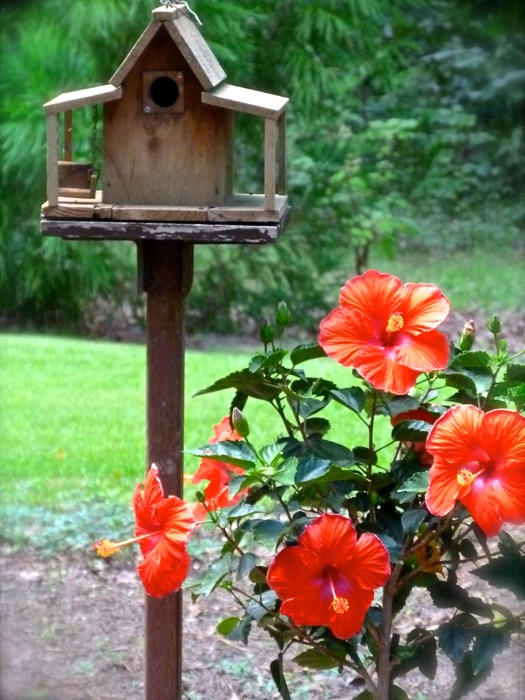The temperature is approaching triple digits outside, and the humidity is climbing. It feels like the tropics. Many perennials and flowering shrubs have retreated from the heat, but there are some tropical plants that revel in the steaminess. Our climate in Alabama is semi-tropical, which means we can enjoy tropical plants outside in the summer, but when frost arrives, these plants will perish unless brought inside. I once rejected tropical plants, because without a greenhouse I don't have a lot of indoor space to over-winter them. However, I have learned to embrace my tropical side, and now I enjoy the bright colors typical of places like South Florida and Hawaii.
Tropical hibiscus (Hibiscus rosa-sinensis) is an evergreen shrub that grows up to fifteen feet tall in frost-free climates, though it can be pruned to control size. It has glossy green leaves and trumpet-shaped blooms, in bright shades of yellow, orange, salmon, and peach, up to six inches or more in diameter. With their bright colors, deep throat and bulls-eye shape, the flowers are attractive to pollinators such as butterflies and hummingbirds.
With their bright colors, deep throat and bulls-eye shape, the flowers are attractive to pollinators such as butterflies and hummingbirds.
Hibiscus plants need full sun and well-drained soil that stays moist but not wet. They will also grow well in containers. They should receive at least an inch of rain each week. They enjoy hot, humid weather, but when the temp goes above 95 degrees (35 degrees C), they are likely to drop their flower buds, especially if they are not getting enough water. These plants also need to be fertilized twice a month, preferably with a high quality organic fertilizer that contains micronutrients.
If your hibiscus is bothered by pests, such as white flies, aphids or mealy bugs, a strong spray of water may be enough to dislodge them. Larger infestations can be treated with horticultural oil or insecticidal soap.
So what do you do when winter comes? To over-winter your plant, you will need to bring the plant indoors once the temperature drops toward the 30's. Once inside, hibiscus plants will like the same temps that humans enjoy. It won't kill them, but they are decidedly uncomfortable with temps in the 50s! So an unheated garage or basement may not be warm enough.
1. First, remove all spent flowers and any dead leaves or stems.
2. Clean the pot of any debris.
3. Prune the plant and cut the stems back to within 4-5 inches of the trunk.
4. Hose thoroughly to remove insects from the plant.
5. Allow to completely dry before bringing inside.
6. Do not repot in the fall.
7. The plant must be allowed to rest between October and February. Do not do anything to stimulate growth. Allow the soil to become almost completely dry between waterings. Do not let water sit in the saucer beneath the pot. Provide only bright indirect light. These measures will cause the plant's leaves to yellow and fall off, therefore inducing dormancy.
By February to March, your hibiscus will begin to grow new leaves. When night-time temps remain above 55 degrees (13 degrees C), it is safe to put your plant back into the garden. Place in a shadier spot for a few days, then begin exposing it to sun. Begin with an hour a day, then each day increase the amount of sun it receives by an hour until it is ready for its permanent full-sun location. Begin fertiliztion after the hibiscus has been in the garden for two to three weeks.
Many hibiscus plants will never bloom as well after their first winter indoors. If you didn't pay much for your plant or if you don't have room indoors, you may decide to just chunk it when frost arrives, then purchase a new one next year. That way you can be sure you will have plenty of gorgeous flowers each year. 